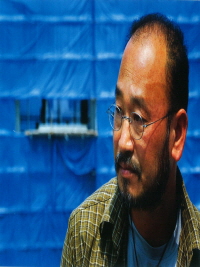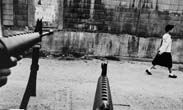Photographic KoreaⅡ_curated by Sun Young KIM
Gap Chul Lee’s insolent camera work reveals the basic impulse repressed in a deserted place, the world of Shamanism, which is deeply rooted in Koreans’ collective unconsciousness. Demons, spirits, and the Qi of madness in folk beliefs, suppressed by western rationalism and pragmatism, are represented in his photos in various styles: sometimes it is captured in the form of dynamism as if the subject matter is flouncing off, sometimes in the form of wickedness, or sometimes in the form of modesty and bashfulness. From the heartless facial expression in an old man, who is slapping his middle aged son, the viewers may find an evil spirit in the face of the father, and from the well-set table for ancestral rites, they may find a deceased spirit. From the girls with flowers in their hair, they may feel the energy of insanity. Yook Myungshim, a senior and teacher, says, “Lee’s camera awakes the basic impulse of life hidden in our unconsciousness and clearly reveals spiritual factors of shamanism sleeping in Korean’s consciousness.”
Lee’s photos convey the reality of our times, the ‘spirit possession of Chosun era,’ which has now vanished, is overlaid. His work process abandons on aesthetic considerations, and he approaches the objects of his photos more intuitively and directly, and hopes for the contingency of a moment. In this way, his work captures a moment of ‘vanished Chosun,’ despite the fact that his photos are only the index of reflected lights of the represented object, on black and white film. His framing prefers a rough cut rather than a detailed composition and clean finish, and his camera work is attracted to the power of chaos rather than a harmonious virtual world. These tendencies are the artist’s unique approaches to the presentation of photography. At the same time, they are a trace of sensitivity for Korean photography, and an artist who reveals Korean sentiments through the subjects of ‘humans,’ which is the theme of this exhibition.















